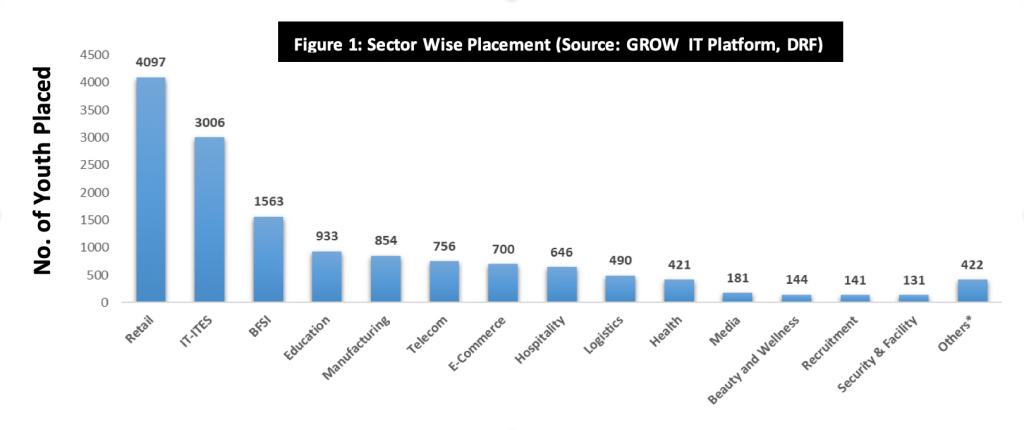5 min read
With 30,000 youth joining the workforce every day, ensuring that they can participate meaningfully in the economy is a challenge. Instead of offering few supplementary courses, we need systemic solutions that upskill India’s young workforce at scale and prepare them for the future.
Timely recommendations are necessary before we lose out on this once in a lifetime demographic advantage that is predicted to end by 2055. This calls for the largest possible collaboration and massive efforts by all stakeholders.
Significance of the Sharda Prasad Committee
The Sharda Prasad Committee, constituted by the Ministry of Skill Development and Entrepreneurship, reflects an effort to address this systemic challenge. Through a report published in 2016, the Committee has provided the first and only available insight around pertinent reforms in the still evolving skilling ecosystem. Here are three recommendations other than the main recommendation of merging 40 Sector Skill Councils (now 37) and have only 21 SSCs to avoid overlap of jurisdiction and better functioning of SSCs.
Recommendation #1: Improve Qualification Packs
The National Occupational Standards (NOS) specify the standard of performance an individual must achieve when carrying out a function in the workplace, laid down by employers. A Qualification Pack (QP) is a set of NOS aligned to a job role. Report observed that QPs developed are narrowly defined and recommended the need of multidisciplinary teams of industry domain experts, academicians, pedagogists, trainers and training professionals to co-develop QPs to make it market relevant.
The report further recommends for these QPs to be standardised across the International Standard Classification of Occupations. This encourages Indian youth to not only be ready for national jobs but also for international requirements.
At Dr. Reddy’s Foundation (DRF)’s new skilling program designed for unemployed youth from marginalised communities, we have observed that youth trained in “Core Employability Skills” for 300 hours got placements across 20 sectors at monthly average salary of more than INR 12000 (refer to Graph 1). This has taught us that youth can be placed in multiple entry-level jobs by just focussing on core employability skills instead of prioritising acquiring so many QPs. This model not only makes the execution scalable but also opens up multiple job options for the youth if they are trained on industry agnostic core employability skills.
*Automobile, NGO, Construction, Entertainment, Infrastructure, Tourism
Recommendation #2: Employers at the core
Report suggests unless the 10-20% of the top employers are part of the Sector Skill Councils skilling programmes will not be effective in India.
India’s skilling story is supply-led. Absence of demand-led models is mainly because programme designers are not listening to employers when developing skilling programmes. This results in youth getting trained in skills which are not aligned to the market requirements. Sometimes, youths are trained in one place but employers are geographically located at another area, which makes the placement process more challenging due to migration complexities. Hence to make any skilling program demand led, it is important to first listen to those employers who are creating jobs. Thoughtfulness is also necessary when selecting the target group for those jobs. These factors can actually be catalytic in transforming the lives of our beneficiaries training in these programmes.
The Centre for Monitoring Indian Economy’s Consumer Pyramids Household Survey estimated a loss of over 10 million jobs in 2018, especially for the better educated. However, this survey also highlights a very interesting fact – 38 million jobs were opened up for people with primary education qualifications. In a country like India, job scopes that leverage technology are also important consideration; 30 million gainful jobs are estimated to be created across 6 sectors (Healthcare, Education, Agriculture, Logistics, Judiciary & Financial Services) by 2025. Hence, during the solution design phase, programme designers need to better understand the fast-changing job market, engage with employers, and keep them at the core of the design to increase the effectiveness of skilling programs.
When interacting with more than 150 employers, we had found out that if we break various service sector job roles into activities, most of the employers are basically looking for different levels of skills – from English and Digital Literacy, to Typing Speed and Accuracy, to Aptitude and Soft Skills, to collaboration and critical thinking in their potential hire. This insight helped us to align our courses as per the market requirement and has impacted our trainees’ (unemployed higher secondary pass or below) average monthly salary from INR 5885 to INR >12,000.
Recommendations #3: the key to ensure quality delivery is the trainers
With only 8,268 practicing trainers per annum and an estimated requirement of 20,000 qualified trainers per annum, the Sharda Prasad Committee Report has highlighted this shortage. The report, therefore, recommends a framework to train trainers across the board – from subjects to pedagogy skills to full centre capacity utilization, and more.
To ensure the quality of our training delivery at DRF, we have introduced a competency test and a comprehensive 33-day Training of Trainers Program to build their competencies further. After completion, trainers are certified by the Learning & Development team, and their performance is continuously assessed through assessments and the students’ learning outcomes whom they are training.
We believe that timely execution of the Sharda Parsad Committee policy recommendations and frameworks can bring about systemic change and impact millions across the young population. At DRF, we have proven the impact; by improving core employability skills of youth, putting employers at the core, and setting high training standards in our new program which helped us in enabling transformation in the lives of more than 23,000 youth in the past 3 years.



















